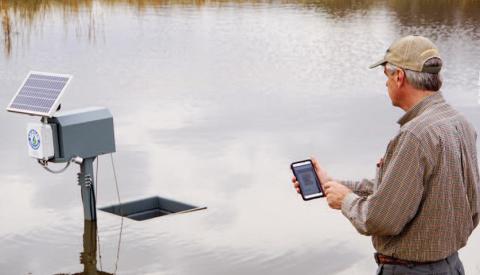Gerald Almy | Originally published in GameKeepers: Farming for Wildlife Magazine. To subscribe, click here.
Faced with a wall of cut cedars and brush I had placed to block one fork in the trail, the deep-chested buck paused and then continued on his way, choosing the unobstructed route leading to a nearby food plot. That decision took him directly in front of my stand, upwind. Minutes later I was field dressing one of the best eight pointers I’ve ever taken. It’s not always that easy, or that successful. But “steering deer” can often be a great tactical aid in hunting. And it can also be used for other management goals, not just to help harvest an animal.
What does it mean to “steer” a deer. Can you manipulate a whitetail’s movement as simply as turning the steering wheel on a vehicle? How significantly can you alter a deer’s intended travel route? And what other reasons are there for doing so besides hunting? Let’s look at some of these questions and examine nine specific ways you can reroute a deer’s travel path.
“Steering deer” basically means “manipulating the direction of travel by altering the habitat.” Exactly how this is accomplished can vary widely. It can be as simple as mowing a path through tall grass. Or it can be as far-reaching as doing Timber Stand Improvement (TSI) or dozer work and laying out extensive windrows to channel deer towards or away from a specific area.
Before going further, let’s clarify one thing. You can’t, in most cases, dramatically alter where a deer is going to travel. They’re not sheep! You can’t make them go somewhere they don’t want to if 1) there’s nothing there for them, or 2) they are wary of the location. You can change their route slightly, but you can’t totally dictate their movements.
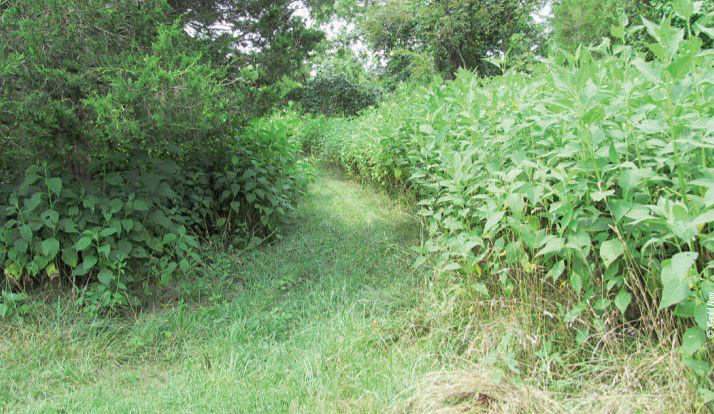
Reasons to Steer Deer
The majority of gamekeepers know the most common reason to manipulate where a deer travels: to encourage it to take a route that gives you the advantage. This may mean 50-150 yards for a rifle or 20-40 yards for a bow. If a food plot, for instance, is 100 yards long a rifle hunter wouldn’t need to steer deer coming to the food source. A bow hunter, on the other hand, would benefit from manipulating their approach so they’re closer, within comfortable shooting range.
In the case above, the far entrances to the food plot could be blocked. In other situations, specific trails can be altered so that they channel deer and position them for a shot. Again, keep in mind; you can’t force them to approach a spot where they don’t feel safe. You must create an approach that possibly offers different options (all in your favor if possible), keep odors to an absolute minimum, and try to foretell wind patterns that will make a whitetail feel at ease.
Often, rather than trails, we’re hunting broader travel corridors where deer from several bedding spots move towards staging areas and evening feed fields - off of a spur ridge, down a hollow or out of a thick marsh.
You can sometimes hunt these broader areas with a rifle from a single spot. But 100-150 yard wide transition corridors are all but impossible for a bowhunter to cover unless there’s something that constricts the sprawling travel route. This is one of the best situations for using the steering tactic, by narrowing the broad travel corridor to a pinch point, or perhaps several structures that will work during different wind conditions. Entice them to use that route by making the walking easier, partially blocking other options, or even adding a food enticement like a fertilized mast tree (more on that later).
Another situation might occur where deer move out of bedding cover in a field of native warm season grasses to approach a food plot. They could come out anywhere, making it hard to know where to set up, but if you mow a trail through the 5-7 foot tall grasses you’ll concentrate on their movement.
These are all hunting-related reasons for steering deer. There are other motives, though, besides setting up an ambush. You may have done some habitat improvement, built a watering pond or created some food sources that deer just don’t seem to be using. A bit of gentle persuasion (steering) may get them to discover and start using that enhancement.
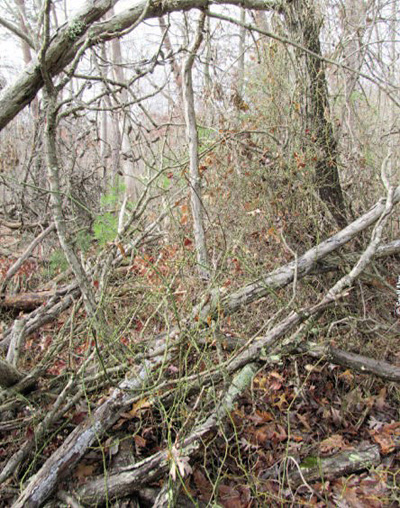
mess unless you sneak up behind him and say “boo.”
That’s the type of blockade you want to persuade deer to
travel the path you prefer.
In other situations you may be trying to protect deer, particularly young bucks. If you have a “trigger-happy” neighbor who hunts right along your property line, steering deer away from that potentially dangerous area is a worthy project. Similarly, if they sometimes wander close to a road where poaching has been a problem, steering them away from that danger spot and avoid potential heartbreak.
Destination and Rewards
While there are exceptions, steering deer for hunting purposes should usually be looked at as a two-part process. The first part is to know where the animals’ destination is. Deer don’t just meander in their travels; they might when they’re feeding, but not when traveling.
Once you have established what and where their objective is (either one you created or located by scouting) altering that travel route can be attempted. Locating a herd’s objective or end destination is the first step in steering deer. If you didn’t create that attraction or destination, you’ll need to learn where it lies in relation to a buck’s daytime bedding area. Once you know point A and point B, the job becomes much easier. Then it becomes a matter of fine tuning or strategically manipulating part of that route to your benefit. It’s also important to keep in mind that their destination can change from day to day as the rut changes, rains make water readily available or food supplies change.
Always remember one thing, a deer doesn’t like to waste energy. The more you’re your alterations attempt to veer him off a direct course towards his destination; the less likely it is to succeed. However, if you actually carve an easier shortcut for him, the odds of success skyrocket.
Time for tactics - there are other ways to steer deer, but here are nine that I’ve used with success. I like to implement most of them during the spring so deer will have time to become accustomed to the alterations and begin using them by the time hunting season arrives.
1. Carve a trail through dense weeds and brush.
This was the first tactic I ever used to “steer” deer, and I actually discovered it by accident. When my wife and I bought our property in western Virginia 25 years ago I carved some trails through areas with thick brush and weeds so we could explore the property and take hikes.
I soon found hoof prints in several of the paths and realized deer were also enjoying the easier travel in those cleared areas. The first buck I killed on the property was walking one of those narrow trails.
Depending on the stem thickness and density of the vegetation, weed-cutters with blades, chain saws, pruning shears or machetes can be used. Mature bucks like these dense-cover areas, but they don’t particularly like walking through them. Make it easier for them.
Remember not to just carve these randomly. Cut them through thick cover connecting point A (bedding cover) and point B (a feeding area or a doe hangout, etc.). And don’t clear a “highway,” if it’s too open the animals might avoid it. Simply make it wide enough for one person or a buck with a wide rack to walk through.
2. Create a food trail.
Logging roads would seem to be great for deer travel, but on my property they get limited use naturally. I fix that by adding the enticement of food. The road may have seemed a bit too open and barren, but add succulent clovers, brassicas or cereal grains and suddenly logging roads become magnets. Deer will typically walk them and nibble as they move towards larger evening feeding areas, giving you an earlier crack at mature bucks that might hold back from the open fields until dark.
If necessary, you might have to “daylight” the logging roads by cutting back a few trees. You need at least four hours of sunlight per day to reach the soil. Then plant shade-tolerant forage such as Hot Spot or Last Bite.
3. Lower a fence.
This is one of the quickest and easiest steering tactics. Whitetails can jump up to nine feet high, but they don’t like to. Find a spot with fresh sign where deer might want to cross and push the top strand down and attach it to the one below. Deer will soon gravitate to this easier crossing point. Be sure to select a good tree for a stand before choosing the crossing spot.
You can augment this further by adding an extra row of “fake wire” above the top strand to give the appearance the fence is higher there. Do this for a fair distance on either side of the crossing spot you’ve chosen. Twine or parachute cord works great for this.
4. Build a brush barrier.
This is a great steering tactic when you have just a small area or couple of spots where deer might veer off the route you want them to take. It’s also good way to steer deer away from a road or property boundary where they might be vulnerable.
Hinge-cut or completely fell low-value trees and lay them across the locations where deer might veer off. You’ll not only steer where they go, you’ll also be improving the habitat and food. Deer will nibble on the newly-available twigs and leaves and the partially-cut trees will continue to offer this additional food for several years. The brush piles will also provide great cottontail cover and turkey nesting areas. Adding cedars or scrub pines to the mix helps make the blockade solid.
5. Mow a swath through tall grasses.
This is similar to #1 but we’re specifically referring to trails through tall bedding grasses like NWSG stands. Native warm season grasses like switchgrass, Indian grass, bluestem, gamma, and plant mixtures such as Blind Spot provide great cover. But if you have a large stand of these, knowing where a deer might exit to approach a feeding area can be difficult. They could pop out anywhere.
To increase the chance they’ll emerge where you want, mow a few narrow paths through the stand. You can use a brush-hog or mower, or hand cut tails with a machete or strong weed cutter. Sure, deer can walk right through the grasses; however most often, unless spooked, they’ll take the easiest route, the path of least resistance.
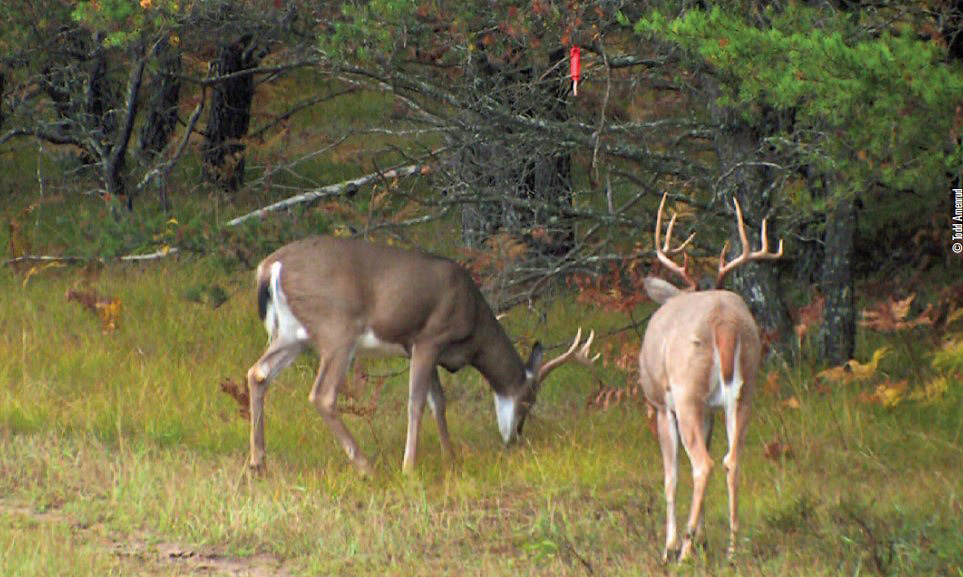
6. Plant a “cover trail” through an area that’s too open.
Most deer steering involves opening up or adjusting a trail through cover. Sometimes you face the opposite challenge. Instead of too much cover, in this situation the habitat is too open and deer won’t approach a choice feeding area until dark.
In this case you need to plant a strip of tall grasses, or a more permanent solution of trees, to offer them enough security cover to feel comfortable approaching the food source during shooting light. Blind Spot or Sudan wheat will grow quickly for a fast solution. For a longer-term cover strip, plant a mixture of switchgrass, bluestem and Indian grass. Or, even conifer trees like spruce or different varieties of pines. Deciduous trees may be mixed in, but evergreens provide a much thicker visual barrier. Strips from 8 to 20 feet wide are all you need. If you make it much wider, a buck may walk right past you hidden inside the dense cover.
7. Lay a doe-in-heat scent trail.
This is a time-tested tactic for the rut. There are several ways to leave a trail, with a drag, by atomizer, or with a boot-pad. Lay a trail from several potential buck approach routes towards good shooting locations upwind or crosswind from your stand. Quality estrus lures like Special Golden Estrus or curiosity smells like Trail’s End #307 are extremely effective during late October through December. Will it always work? No, but it’s worth a try almost any time in November, especially if you combine it with a mock scrape and licking branch setup.
8. Use herbicide to create a trail.
A bear taught me this one. We’re overrun with bears where I live in western Virginia. Every spring they make raids to tear up bird feeders, trash or last year to destroy two bags of Biologic seed I’d stored in an unsecured shed. Instead of this typical fare one of these marauders got a hankering for a 2-1/2 gallon container of 41-percent glyphosate! The teeth marks told the tale. I don’t know what he liked about it, but there was a trail heading down through brush away from my house where a few weeks later all the vegetation had died. I’ve sprayed fields and never got as good a “kill” as he did dragging his glyphosate-soaked belly fur through the foliage.
The “herbicide trail” simply offered easier walking. Since then I’ve employed this tactic on several occasions as an alternative to cutting trails with a machete or weed trimmer. Use a backpack sprayer or hand-held tank and mix the herbicide hot for a strong kill. If necessary, repeat in two weeks. After the vegetation dies you can stomp it down with clean boots to make the trail even more inviting.
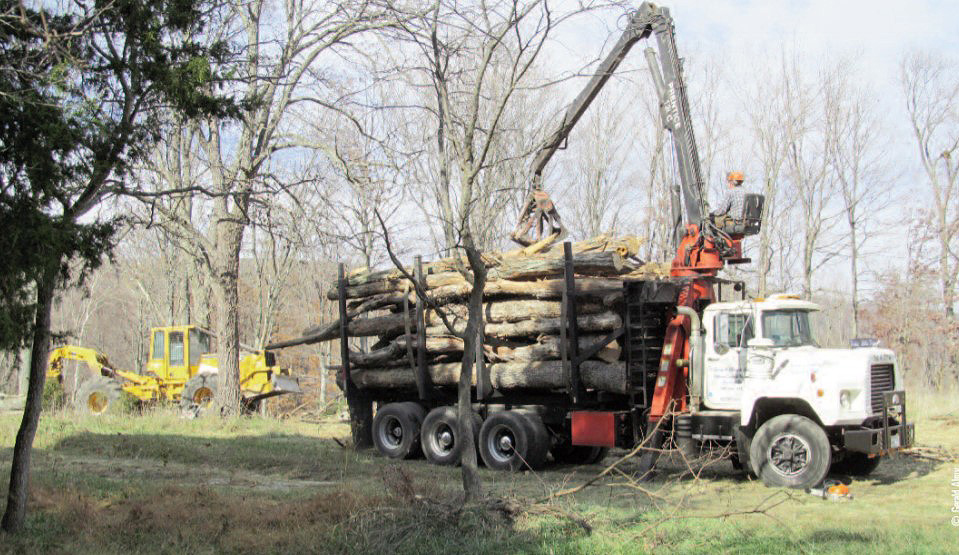
9. Timber stand improvement (TSI) trails.
If you plan to conduct a TSI cut on your land, ask the logger to push tree tops and slash into windrows in specific areas to guide deer movement. Make sure to have a plan and discuss it before the cut. If you’re skilled with a chainsaw you can do this yourself, laying out long trails that will channel deer towards areas that give you the advantage.
Lay some larger trees parallel and some smaller tops at 90 degrees. Be sure to allow some “exit points” where a deer can veer off so they don’t feel totally trapped.
No, you can’t lead deer like sheep, but they’re not as stubborn as a donkey, either. With a careful, thought-out approach, you can alter their routes just enough to make it easier to harvest them or steer them away from dangerous areas such as roads or trigger-happy neighbors.

















